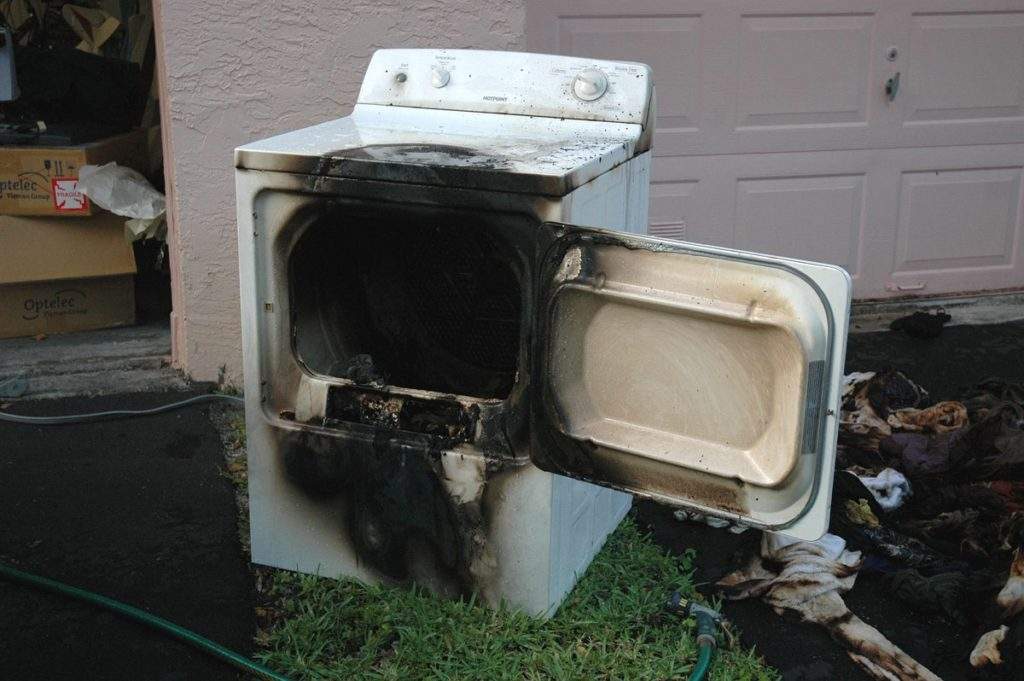Clogged Dryer Vents Ignite 15,000 House Fires a Year

Nice, toasty towels right out of the dryer feel great in the winter. Unfortunately, residential clothes dryers can toast more than towels.
Flammable lint can work its way through your dryer’s lint filter and contact hot machine parts, including the dryer’s heating element. Worse, still, lint can clog exhaust vents, resulting in the build-up of volatile gasses. This scenario fuels more than 15,000 U.S. house fires each year, according to the U.S. Consumer Product Safety Commission.
Not surprisingly most of the fire damage from clothes dryers happen in the winter. 27 percent of all dryer fires are started by lint; another 26 percent of fires are started by the clothes in the dryer, according to the National Fire Protection Association. And every year fire damage from clothes dryer fires add up to more than $100 million in losses!
How do you know if you have a potential clothes dryer fire?
Fortunately, clothes dryers in good repair employ effective barriers to catch lint and let air pass reducing the likelihood of fire damage. So lint build-up doesn’t happen overnight, and your dryer will tip you off if lint starts piling up. You just have to pay attention and investigate when:
- Your dryer seems to radiate abnormally high heat. Same with clothes in the dryer.
- You notice any new odors seeming to start at your dryer. Hot machinery can release acrid, smoky odors, while bacterial and fungal growths tend to emit gassy or musty odors.
- Your dryer takes longer to finish a load or fails to completely dry your laundry.
- Your dryer makes strange noises. When metal heats up, it can warp. Warped machinery tends to complain. Loudly.
- You see lint build-up behind the lint filter when you remove and clean it. Also watch for lint build-up around, underneath and behind the dryer.
Can you be more proactive to prevent fire damage?
Of course, you’re right when you say, “I’m not going to rely on an inanimate machine to tell me when my family or business is at risk for a house fire.” The potential consequences are too grave, and reasonable precautions to prevent fire damage are too simple. Here are a few things you can do to catch dryer lint build-up before it raises the risk of fire:
- Clean your lint filter after every dryer load. Check it before every load, too.
“It starts with cleaning out the lint filter every time you use the dryer.” says John Hall, Ph.D., division director of fire Analysis & Research for the National Fire Protection Association. He also advises clearing out the vent pipe to reduce the chance of fire and to maintain the efficiency of the dryer.
- Check your external dryer vent while the dryer is operating.
Ensure that the vent is not clogged with lint or obstructed with plant growth or animal nests (or animals, for that matter). Little or no lint should be present in this exhaust. If airflow is restricted, stop operating your dryer immediately and investigate.
Following the manufacturer’s instructions when installing the vent pipe is critical. Use a short, straight pipe that is an adequate distance from the wall. Reducing bends in the dryer vent pipe creates less opportunity for lint to accumulate. If you must to vent your dryer over a distance, a dryer vent fan is a great investment to consider. Dryer vent fans are automatic electric devices that speed up airflow through the duct every time you turn on your dryer to keep things moving along.
Research shows that flexible foil or plastic ducts can sag and lead to lint buildup at low points. Metal ducts of any variety don’t sag, and they’re more likely to contain any fires that would start.
- Check for combustibles around the dryer.
It’s an easy problem to overlook in a small laundry room. Move flammables like cleaning supplies far away from your dryer to prevent fire damage.
- Regularly clean around your dryer.
Be sure to clean around, under and behind your dryer. Inspect for excessive lint build-up and excessive dust. Dust is flammable, too!
- Pay attention to your dryer’s normal operations.
Changes in drying time, sounds and heat levels can signal a potential problem. Investigate when the normal variables of your clothes dryer changes.
- Read care labels.
If the tag reads ‘tumble dry low’, it could be a problem if you have the dryer setting on high. Also use caution with certain items like bath mats, padded bras and bibs—they may contain rubber that could heat up and catch fire when exposed to hot temperatures.
- Call a professional with experience in cleaning and inspecting dryer vents.
If you suspect or know that your dryer’s exhaust vent is clogged with lint, stop operating it immediately.
When you call an expert, you get the peace of mind that comes from knowing the job is done safely and thoroughly. It’s also inexpensive, especially when compared to the fire damage restoration costs of even a small fire.
And don’t wait until your dryer squawks to call a professional. At a minimum, dryer vents should be inspected and cleaned every two years to catch and remove potentially dangerous lint and debris build-up that can result in destructive house fires.
Your dryer is convenience that makes your life easier. Don’t take it for granted and let it make your life harder. Check out the Abbotts blog for more tips and advice to keep your family and property safe.

